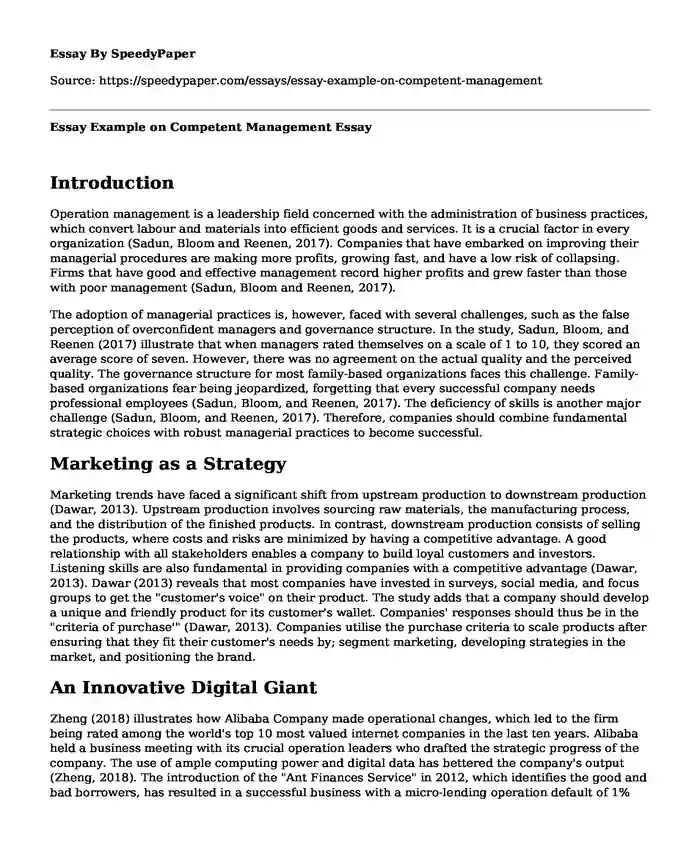
| Type of paper: | Essay |
| Categories: | Company Management Business |
| Pages: | 3 |
| Wordcount: | 733 words |
Introduction
Operation management is a leadership field concerned with the administration of business practices, which convert labour and materials into efficient goods and services. It is a crucial factor in every organization (Sadun, Bloom and Reenen, 2017). Companies that have embarked on improving their managerial procedures are making more profits, growing fast, and have a low risk of collapsing. Firms that have good and effective management record higher profits and grew faster than those with poor management (Sadun, Bloom and Reenen, 2017).
The adoption of managerial practices is, however, faced with several challenges, such as the false perception of overconfident managers and governance structure. In the study, Sadun, Bloom, and Reenen (2017) illustrate that when managers rated themselves on a scale of 1 to 10, they scored an average score of seven. However, there was no agreement on the actual quality and the perceived quality. The governance structure for most family-based organizations faces this challenge. Family-based organizations fear being jeopardized, forgetting that every successful company needs professional employees (Sadun, Bloom, and Reenen, 2017). The deficiency of skills is another major challenge (Sadun, Bloom, and Reenen, 2017). Therefore, companies should combine fundamental strategic choices with robust managerial practices to become successful.
Marketing as a Strategy
Marketing trends have faced a significant shift from upstream production to downstream production (Dawar, 2013). Upstream production involves sourcing raw materials, the manufacturing process, and the distribution of the finished products. In contrast, downstream production consists of selling the products, where costs and risks are minimized by having a competitive advantage. A good relationship with all stakeholders enables a company to build loyal customers and investors. Listening skills are also fundamental in providing companies with a competitive advantage (Dawar, 2013). Dawar (2013) reveals that most companies have invested in surveys, social media, and focus groups to get the "customer's voice" on their product. The study adds that a company should develop a unique and friendly product for its customer's wallet. Companies' responses should thus be in the "criteria of purchase'" (Dawar, 2013). Companies utilise the purchase criteria to scale products after ensuring that they fit their customer's needs by; segment marketing, developing strategies in the market, and positioning the brand.
An Innovative Digital Giant
Zheng (2018) illustrates how Alibaba Company made operational changes, which led to the firm being rated among the world's top 10 most valued internet companies in the last ten years. Alibaba held a business meeting with its crucial operation leaders who drafted the strategic progress of the company. The use of ample computing power and digital data has bettered the company's output (Zheng, 2018). The introduction of the "Ant Finances Service" in 2012, which identifies the good and bad borrowers, has resulted in a successful business with a micro-lending operation default of 1% compared to the World Bank's rating of 4%. (Zheng, 2018). For a successful business, organizations must ensure that machine learning fuels operational decisions.
Transient Advantage
McGrath (2013) provides a competitive advantage cycle, which begins with a launch process where enterprises spot an opportunity, gather resources, and capitalize on it (McGrath, 2013, p.64). Ramp up is the second stage where the ideas are tabled for discussion. The ramp-up stage requires people who can bring together the right information and resources at the right time (McGrath, 2013, p.64). The third stage is the exploration stage; at this stage, an organization needs skilled people in management, accounting, and profit analysis (McGrath, 2013). The last step is reconfiguration, which requires quality managerial skills to maintain a competitive advantage. Companies need radical thinkers in models and resources to help them know when their competitive advantages are fading away, especially those in high-velocity industries. However, sometimes the cycle does not go as organized, and the manager should know when to disengage (McGrath, 2013).
Conclusion
In conclusion, the articles indicate that effective strategic managerial practices are essential in organizations as strategies are being made. It is important to seek advice from competent personnel and members of the staff. The introduction of live data in analyzing companies' progress is more significant than the human analyzed data.
References
Dawar, N. (2013) When Marketing Is Strategy. Harvard Business Review.
McGrath, R. (2013) Transient Advantage; Achieving a sustainable competitive edge is nearly impossible these days. A playbook for strategy in a high- velocity world. Harvard Business Review.
Sadun, R., Bloom, N., and Reenen, J. (2017) Why Do We Undervalue Competent Management? Neither Great Leadership nor Brilliant Strategy Matters without Operational Excellence. Harvard Business Review.
Zeng, m., 2018. Alibaba and the Future of Business. Harvard Business Review.
Cite this page
Essay Example on Competent Management. (2024, Jan 03). Retrieved from https://speedypaper.com/essays/essay-example-on-competent-management
Request Removal
If you are the original author of this essay and no longer wish to have it published on the SpeedyPaper website, please click below to request its removal:
- Free Essay on the Dabbawala Supply Chain Model
- Finance Essay Example on the Cost of Ownership
- Free Essay Sample about Installing Hospital Healthcare Monitoring System
- Impact of Institutional Investors on Wealth Effects of Overseas M&A of Chinese Companies - Paper Sample
- Ethical Dilemma Case Study Related to the Ads with Gay and Lesbian Inclusion
- Essay Sample: Disney's Expedition Everest
- Essay Sample on Conflict Management
Popular categories




